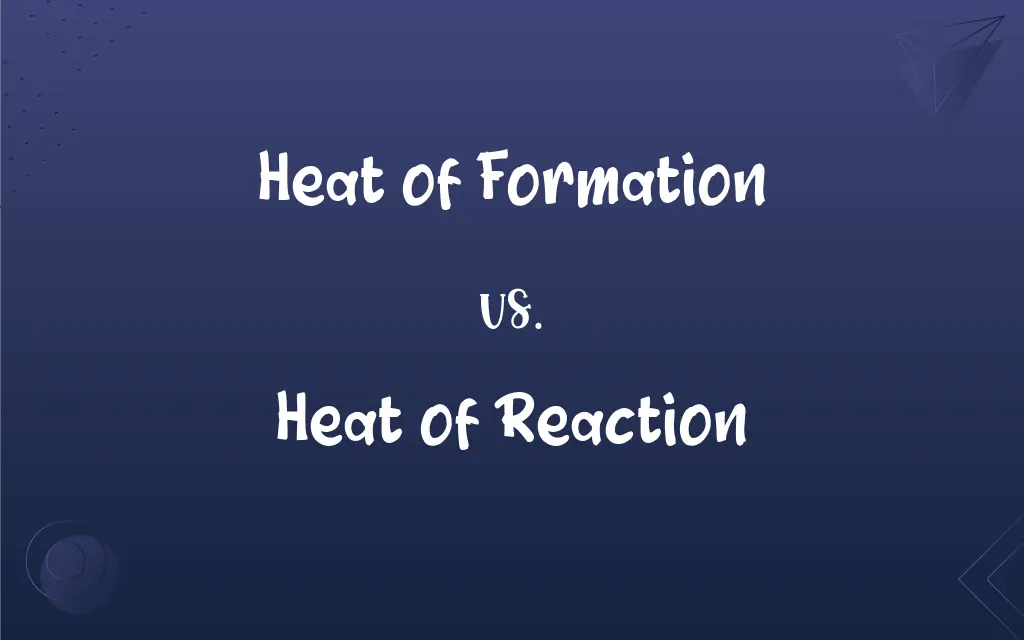Heat of Formation vs. Heat of Reaction: What's the Difference?
Edited by Janet White || By Harlon Moss || Updated on October 24, 2023
The heat of formation is the energy change when one mole of a compound is formed from its elements, while the heat of reaction is the energy change during a chemical reaction.

Key Differences
The heat of formation pertains to the energy change when a single mole of a compound is produced directly from its elements in their standard states. This means it's a specific type of heat measurement, indicating how much energy is released or absorbed when elemental substances come together to form compounds. In contrast, the heat of reaction refers to the energy change during any chemical reaction, whether it involves the formation of compounds from elements or other processes.
Heat of formation values are particularly useful in predicting the heat of reactions. This is because, using Hess's Law, the heat of any reaction can be estimated by considering the difference between the heats of formation of products and reactants. On the other hand, the heat of reaction is a broader term, encompassing all kinds of chemical reactions, not just formation reactions.
The heat of formation is typically tabulated for a wide range of compounds. Chemists refer to these tables when predicting the energy changes in reactions. The heat of reaction, however, must be determined experimentally unless it can be deduced from known heats of formation.
In essence, the heat of formation provides a foundational metric from which many other thermodynamic properties, including the heat of reaction for various processes, can be derived. The heat of reaction, meanwhile, serves as an overarching term that describes energy changes in all chemical reactions, whether or not they involve compound formation.
Comparison Chart
Definition
Energy change when one mole of a compound forms from its elements.
Energy change during any chemical reaction.
ADVERTISEMENT
Specificity
Pertains to formation reactions only.
Applies to all chemical reactions.
Measurement
Typically tabulated for compounds.
Often determined experimentally.
Use in Thermodynamics
Used to predict heat of reactions using Hess's Law.
Direct measure of energy change in a reaction.
Relationship to Elemental State
Always involves substances forming from elements in standard states.
Can involve any reactants and products, not necessarily elemental substances.
Heat of Formation and Heat of Reaction Definitions
Heat of Formation
This value is vital for understanding a compound's stability.
A compound with a highly negative heat of formation is typically very stable.
ADVERTISEMENT
Heat of Reaction
This value can be either positive (endothermic) or negative (exothermic).
The dissolution of some salts in water has a positive heat of reaction.
Heat of Formation
The heat of formation measures the energy change during compound creation from elements.
The heat of formation for water is negative, indicating it releases energy.
Heat of Reaction
It encompasses all types of chemical reactions, not just formation.
The heat of reaction for a decomposition reaction might be endothermic.
Heat of Formation
It's a specific type of heat measurement tied to elemental combination.
The heat of formation for sodium chloride is exothermic.
Heat of Reaction
It's a broad term indicating the energy dynamics of reactions.
Studying the heat of reaction helps in understanding reaction mechanisms.
Heat of Formation
It represents the enthalpy change for the production of one mole of a substance.
Methane's heat of formation can be found in thermodynamic tables.
Heat of Reaction
The heat of reaction provides insight into reaction spontaneity.
If the heat of reaction is highly negative, the process is likely spontaneous.
Heat of Formation
The heat of formation is a fundamental thermodynamic quantity.
By knowing the heat of formation, chemists can predict reaction behaviors.
Heat of Reaction
The heat of reaction is the energy change during a chemical process.
The heat of reaction for the combustion of gasoline powers cars.
FAQs
What does the heat of formation measure?
The heat of formation measures the energy change when one mole of a compound forms from its elements.
Do all chemical reactions have a heat of reaction?
Yes, all chemical reactions involve an energy change, which is the heat of reaction.
Is the heat of formation always negative?
No, it can be either negative (exothermic) or positive (endothermic), depending on the compound.
How is the heat of reaction different from the heat of formation?
The heat of reaction refers to the energy change during any chemical reaction, whereas the heat of formation is specific to the formation of compounds from elements.
Why is the heat of formation important in chemistry?
It provides foundational data for predicting energy changes in various chemical reactions.
Why is the heat of formation zero for elemental substances in their standard states?
By definition, elements in their standard states are used as reference points, so their heat of formation is zero.
Is the heat of reaction always the same for a particular reaction?
No, it can vary based on conditions like temperature and pressure.
Is the heat of formation different for different allotropes of an element?
Yes, different allotropes have different heats of formation.
How are the heat of formation and reaction related to reaction spontaneity?
While they provide energy change information, spontaneity also depends on factors like entropy.
Can a reaction with a positive heat of reaction be spontaneous?
Yes, if the entropy increase is significant enough to make the Gibbs free energy change negative.
Can the heat of reaction be used to determine reaction rates?
No, the heat of reaction indicates energy change but not the speed of the reaction.
Can the heat of reaction be derived from the heat of formation values?
Yes, using Hess's Law, the heat of reaction can be estimated from known heats of formation.
Does the heat of reaction always need to be determined experimentally?
While often determined experimentally, it can also be deduced from known heats of formation.
What does a negative heat of reaction indicate?
A negative heat of reaction indicates the reaction releases energy, making it exothermic.
Do all formation reactions have a heat of formation value?
Yes, all formation reactions have an associated heat of formation, indicating the energy change during compound formation from elements.
Can the heat of reaction be zero?
Yes, in an isothermal and adiabatic process where no heat is exchanged, the heat of reaction can be zero.
How do chemists use the heat of formation in practical applications?
They use it to predict reaction behaviors, study compound stability, and design energy-efficient processes.
Are the units of heat of formation and reaction the same?
Typically, both are measured in energy units like joules or kilojoules per mole.
What does a positive heat of formation indicate?
A positive heat of formation indicates that energy is absorbed when a compound forms from its elements.
Are heat of formation values typically tabulated?
Yes, they are often found in thermodynamic tables for a wide range of compounds.
About Author
Written by
Harlon MossHarlon is a seasoned quality moderator and accomplished content writer for Difference Wiki. An alumnus of the prestigious University of California, he earned his degree in Computer Science. Leveraging his academic background, Harlon brings a meticulous and informed perspective to his work, ensuring content accuracy and excellence.
Edited by
Janet WhiteJanet White has been an esteemed writer and blogger for Difference Wiki. Holding a Master's degree in Science and Medical Journalism from the prestigious Boston University, she has consistently demonstrated her expertise and passion for her field. When she's not immersed in her work, Janet relishes her time exercising, delving into a good book, and cherishing moments with friends and family.































































